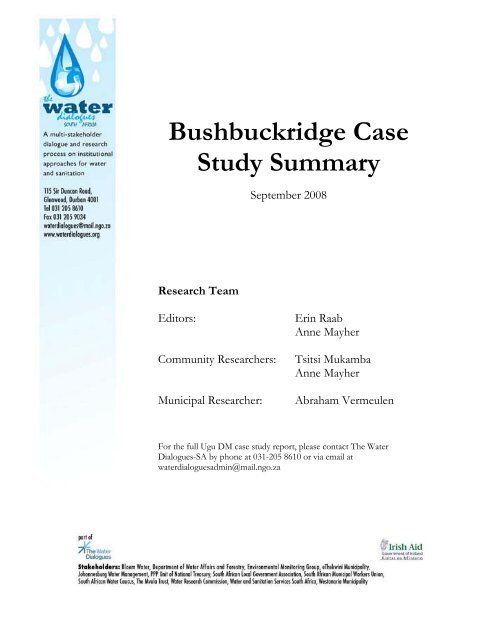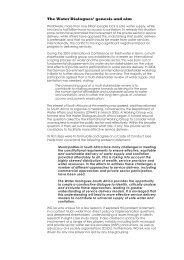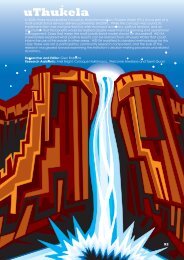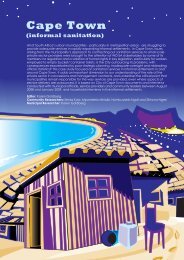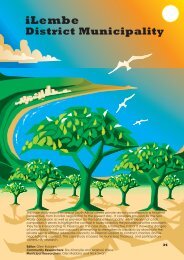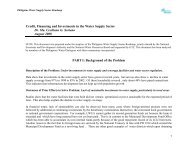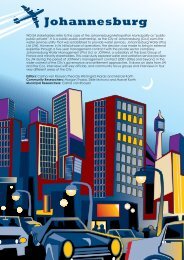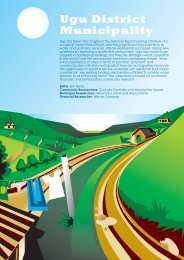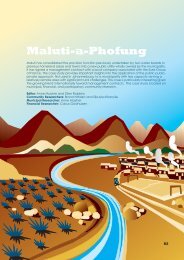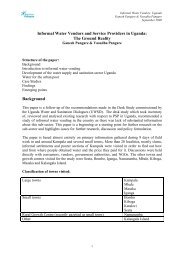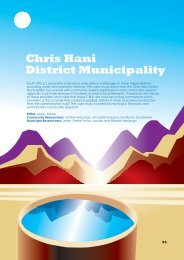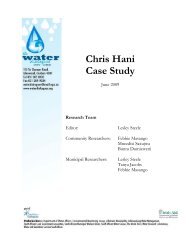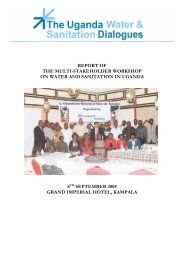Bushbuckridge Case Study Summary - The Water Dialogues
Bushbuckridge Case Study Summary - The Water Dialogues
Bushbuckridge Case Study Summary - The Water Dialogues
You also want an ePaper? Increase the reach of your titles
YUMPU automatically turns print PDFs into web optimized ePapers that Google loves.
<strong>Bushbuckridge</strong> <strong>Case</strong><br />
<strong>Study</strong> <strong>Summary</strong><br />
September 2008<br />
Research Team<br />
Editors:<br />
Community Researchers:<br />
Municipal Researcher:<br />
Erin Raab<br />
Anne Mayher<br />
Tsitsi Mukamba<br />
Anne Mayher<br />
Abraham Vermeulen<br />
For the full Ugu DM case study report, please contact <strong>The</strong> <strong>Water</strong><br />
<strong>Dialogues</strong>-SA by phone at 031-205 8610 or via email at<br />
waterdialoguesadmin@mail.ngo.za
Background<br />
In South Africa (SA), access to a minimum level of potable water and sanitation facilities are a<br />
human right. All citizens are meant to receive a minimum of 6 kilolitres of clean water per<br />
month, have a standpipe within 200 metres of their home and have at least a drop or VIP toilet.<br />
Since the first democratically-elected government took office in 1994, the extension of basic<br />
services to those previously denied access has been made a priority. Amongst the most basic and<br />
critical of these is the access of citizens to clean water and sanitation services. However, not<br />
everyone has even this minimum of access, and there are great numbers of people without water<br />
and sanitation services across the country. While this is due in large part to apartheid policies,<br />
some people say the new democratic government should have done more since 1994 to extend<br />
water and sanitation infrastructure to all citizens.<br />
<strong>The</strong> <strong>Water</strong> Services Act of 1997 established the ‘<strong>Water</strong> Services Authority’ (WSA) function. <strong>The</strong><br />
WSA is meant to ensure the delivery of water and sanitation services to SA residents. <strong>The</strong><br />
Municipal Structures Act of 2000 decentralised the WSA function to local government by<br />
assigning it to either the local or district municipalities, depending on which was more able to<br />
perform the duties in each area. <strong>The</strong> WSA must determine the best way to deliver water and<br />
sanitation services by choosing a ‘<strong>Water</strong> Services Provider’ (WSP). <strong>The</strong> WSP does the actual<br />
delivery of services. A municipality can decide it would like to be the WSP itself (an internal<br />
model), it can partner with another organisation, or it can contract an outside organisation to<br />
complete all of WSP responsibilities (external model). <strong>The</strong>re are many factors that must be<br />
considered by the WSA in order to decide the best mix of organisations to fulfil a WSP’s<br />
responsibilities. <strong>The</strong> “Section 78” process requires a WSA to carefully evaluate the benefits and<br />
drawbacks of the options available to it before it may select a WSP. Each municipality must<br />
ensure the institutional model it chooses is carefully designed to address its particular context<br />
and challenges.<br />
<strong>The</strong> <strong>Water</strong> <strong>Dialogues</strong> – South Africa (WD-SA) is trying to understand the best institutional<br />
models for South Africa to achieve universal access to water and sanitation services. To do this,<br />
WD-SA has invited key stakeholders from national and local government, private companies,<br />
civil society, and the unions to discuss the most important issues and challenges facing the water<br />
and sanitation sector. WD-SA aims to bring a range of views and constituencies round the table<br />
to discuss, review and analyse different institutional approaches to water and sanitation delivery<br />
services. Through collaborative research and discussions around the findings WD-SA seeks to<br />
understand the process of choosing institutional approaches, as well as the impact different<br />
approaches have on the quality and level of services received by residents.<br />
To better understand the true situation, WD-SA has been conducting research in District<br />
Municipalities across the country. <strong>The</strong> research was designed as a series of case studies.<br />
Researchers conducted in-depth interviews with municipal officials and organised participatory<br />
community workshops in four diverse areas of each municipality. A financial expert also<br />
reviewed WSP documents. <strong>The</strong> research tries to understand the situation and challenges of both<br />
the provider (government) and recipients (community members) of the services.<br />
This document summarises the case study research conducted by <strong>The</strong> <strong>Water</strong> <strong>Dialogues</strong>-South<br />
Africa in the <strong>Bushbuckridge</strong> Local Municipality (LM) around the approach <strong>Bushbuckridge</strong> LM<br />
has taken toward the delivery of water and sanitation services to its residents. <strong>The</strong> case of<br />
<strong>Bushbuckridge</strong> provides a critical opportunity to review different institutional arrangement types.<br />
It is as an interesting case study as it is a Local Municipality that has undertaken both the <strong>Water</strong><br />
Services Authority and <strong>Water</strong> Services Provider roles and has received extensive technical<br />
2
support and capacity-building from the Department of <strong>Water</strong> Affairs and Forestry (DWAF) yet,<br />
based on its operating expenditure, the <strong>Bushbuckridge</strong> LM has been identified by WD-SA as<br />
having low capacity to undertake these duties.<br />
In this case study summary, the context of the research will be established through key<br />
demographic facts about the LM, followed by a chart which summarises important data gathered<br />
from and about each of the participating communities. Key findings are then discussed,<br />
highlighting the main issues and important points of the research.<br />
3
Introduction to <strong>Bushbuckridge</strong> Local Municipality<br />
Historically, the question of under which province the <strong>Bushbuckridge</strong> area should fall has been a<br />
political issue since before 1994. During the transitional period leading up to the 1994 national<br />
and provincial elections in South Africa, nine provinces were established from four formerly<br />
“white, coloured & Indian” provinces and ten formerly “black” homeland administrations.<br />
Before 1994, the <strong>Bushbuckridge</strong> area had been partly Lebowa (North Sotho/Sipedi), partly<br />
Gazankulu (Shangaan/Tsonga – the majority) and partly KaNgwane (Siswati – very small<br />
portion) homelands. A decision was made to include it into the Northern (now Limpopo)<br />
Province, but disagreements continued and the area was added to the Mpumalanga province in<br />
2005. <strong>The</strong> area has a majority of Shangaan, a large minority of North Sotho and a small minority<br />
Siswati. <strong>The</strong> former homeland divisions still run deep in the political psyche and are manifested<br />
in two distinct factions within the ruling party (ANC). This political schism has shaped much of<br />
the decision-making around institutional arrangements, and the prolonged period of<br />
disagreement and uncertainty about jurisdiction also affected services delivery (which will be<br />
discussed further in the following sections).<br />
<strong>Bushbuckridge</strong> Local Municipality is now one of five local municipalities in the Ehlanzeni<br />
District Municipality in the Mpumalanga Province. Mpumalanga is in the north-east of South<br />
Africa, and <strong>Bushbuckridge</strong> is situated in the lowveld area in the north east of the province. <strong>The</strong><br />
well-known Kruger National Park provides <strong>Bushbuckridge</strong> with its eastern boundary, and the<br />
Limpopo Province borders Northern edge of the LM.<br />
Figure 1: Map Denoting Location of BBR LM<br />
Source: Maluleke et al. 2005 [citing Demarcation Board]<br />
Under apartheid, almost all of <strong>Bushbuckridge</strong> LM was under the jurisdiction of the Lebowa and<br />
Gazankulu former homeland areas, which explains in some part the extreme under-development<br />
of the LM. Though there are a few small urban centres (including Acornhoek, Thulamahashe,<br />
<strong>Bushbuckridge</strong>, Marite, Dwarsloop, and Mkhuhlu), rural areas make up the majority of<br />
<strong>Bushbuckridge</strong> LM, and most of the land is considered part of traditional “tribal” areas. Urban<br />
areas tend to be wealthier and have access to better infrastructure, more economic opportunities<br />
and greater range of municipal services than rural areas. Rural households depend largely on<br />
external income sources, e.g. state grants and remittances from relatives working in urban areas.<br />
4
Key demographic information about <strong>Bushbuckridge</strong> LM includes:<br />
• <strong>Bushbuckridge</strong> LM has a population of around 720,000 1 .<br />
• 65 percent of the population is under the age of 24 years 2 .<br />
• Small rural villages comprise 29 percent of the population, while dense villages represent<br />
61 percent, and about 9 percent of the population lives in urban centres.<br />
• 84 percent of the population is classified by the municipality as “indigent,” in that they<br />
earn less than R1300 per household per month.<br />
• <strong>The</strong> rate of unemployment is extremely high – only 18 percent of the population is<br />
employed (82 percent unemployed) 3 .<br />
1 WSDP 2006/07<br />
2 Parliamentary Monitoring Group (PMG) 2008<br />
3 Parliamentary Monitoring Group (PMG) 2008<br />
5
Participating Communities<br />
For the WD-SA case study research, communities were chosen with the aim of achieving an accurate representation of the different types of<br />
communities’ (Chart1 below) diverse experiences and researchers worked closely with the ward councillors and other community officials to identify<br />
appropriate areas. Participatory community workshops were held in four distinct areas and participants conveyed information pertaining to the<br />
access, level, quality and affordability of services that are currently being provided. Researchers were also interested in participants’ knowledge of the<br />
free basic water policy and the relationship the LM has with communities. <strong>The</strong> workshops added texture to the information received from the<br />
municipality and provided a unique overall ‘take’ different from that of municipal officials.<br />
<strong>The</strong> four communities were diverse in their demographics and experience of water and sanitation services. Table 1 gives a summary of key<br />
information about the communities.<br />
Table 1: <strong>Summary</strong> of Community Contextual Information<br />
Community Welverdiend Dingleydale Belfast Mkhuhlu Township<br />
Location Remote rural village on the Northern<br />
border (pop. 8322)<br />
Rural scattered village in the Midlands<br />
area (pop. 2227)<br />
Rural dense village (pop. 6182) Formal urbanised town in Southern<br />
area (pop. over 40,000)<br />
Overview of Boreholes, communal standpipes, and Canal, rivers, communal taps<br />
Yard taps, communal standpipes, rivers Household and yard taps and<br />
<strong>Water</strong><br />
Services<br />
rivers.<br />
communal standpipes.<br />
<strong>Water</strong> is pumped from boreholes into a<br />
main reservoir. During the rainy<br />
seasons rivers are used as a source of<br />
water, and rain water is also harvested<br />
in shallow dams (mainly for<br />
construction and livestock).<br />
Some areas suffer serious water<br />
scarcities, and the section where<br />
refugees stay (Twanano Village) has no<br />
water services.<br />
Since the early 1960s when the scheme<br />
was established the irrigation canal has<br />
been the major source of water. A river<br />
nearby is also a major source of water.<br />
<strong>The</strong>re is an acute shortage of clean.<br />
<strong>The</strong> small package plant established by<br />
the Lebowa Government provides<br />
purified water to the community,<br />
however workshops revealed the plant<br />
does not have the capacity to provide<br />
water for the entire community. Very<br />
few people access water from this<br />
source (only 2 streets near the plant<br />
receive purified water). <strong>The</strong> rest of the<br />
community relies on raw canal water.<br />
Two boreholes in the village pump<br />
water into the Belfast reservoir. Many<br />
households have yard connections<br />
(most of which they have connected<br />
themselves).<br />
Households in closer proximity to the<br />
reservoir receive more water than do<br />
households which are far away from<br />
the reservoir.<br />
When the water quantity is low or<br />
nonexistent, community members<br />
access water via nearby rivers and<br />
wells.<br />
<strong>Water</strong> is provided to the township via<br />
yard taps from the Hoxani treatment<br />
plant which purifies water from the<br />
Sabie River. Outside the township,<br />
some areas have piped water with<br />
communal taps and some still access<br />
water from Sabie, Benjani, and<br />
Xisimeleni Rivers
Community Welverdiend Dingleydale Belfast Mkhuhlu Township<br />
Sanitation Pit latrines, ‘the bush’<br />
Pit latrines, ‘the bush’<br />
Pit latrines, few water-borne sewage <strong>Water</strong>-borne sewage, VIP and pit<br />
Services<br />
connections<br />
latrines.<br />
Free<br />
<strong>Water</strong><br />
Basic<br />
Residents generally use pit latrines they<br />
have made themselves. Some<br />
households are equipped with waterborne<br />
sewage but cannot use it due to<br />
lack of water.<br />
Some residents have constructed pit<br />
latrines, but many still do not have<br />
access to any level of formal sanitation<br />
and continue to use ‘the bush’.<br />
<strong>The</strong> main form of sanitation services is<br />
the pit latrine, which community<br />
members have constructed themselves.<br />
<strong>The</strong> health clinics and a few other<br />
places (mostly businesses) are equipped<br />
with water-borne sewage.<br />
<strong>The</strong> community does not pay for water. <strong>The</strong> community does not pay for water. <strong>The</strong>y do not pay for water, although<br />
when water is scarce residents hire a<br />
bakkie (R70) to fetch water from nearby<br />
villages.<br />
FBW is reflected on household bills.<br />
Participants were aware of the FBW<br />
policy, but some were unsure if they<br />
actually received it.<br />
In order to investigate the workings behind community experiences with water services, this study gathered information regarding the provision of<br />
water by four different providers: <strong>Bushbuckridge</strong> Local Municipality, the former Bohlabela District Municipality, the Department of <strong>Water</strong> Affairs<br />
and Forestry, and the <strong>Bushbuckridge</strong> <strong>Water</strong> Board - the bulk supplier. Unfortunately, very little data– historical or current – was available from any of<br />
the providers for use in the analysis of this research.<br />
<strong>The</strong> responsibility for water and sanitation services delivery has rested with all four of these providers over the past 12 years. Prior to 2006, BLM was<br />
the WSP for urban areas only, so DWAF and the former Bohlabela DM were the service providers for the three rural areas included in this study, but<br />
when Bohlabela was disestablished BLM became responsible for services delivery in the rural areas as well as the urban. Currently the municipality is<br />
serving as both <strong>Water</strong> Services Authority and <strong>Water</strong> Services Provider – this arrangement has been in place since 2006. As the WSA, it must oversee<br />
the use and management of water resources. As the WSP, it must ensure water is provided to users under its jurisdiction.<br />
7
Overview of Findings<br />
1. <strong>Bushbuckridge</strong> LM is currently struggling to perform all of the necessary functions,<br />
although water and sanitation services do remain a top priority of officials.<br />
<strong>Bushbuckridge</strong> LM faces incredible challenges in its water and sanitation services provision due<br />
to the historic underdevelopment of the area under apartheid (and thus little existing<br />
infrastructure), as well as limited capacity in terms of both human and financial resources. This<br />
research raised concerns regarding whether <strong>Bushbuckridge</strong> LM had the capacity to take over the<br />
WSA and WSP functions from Bohlabela District Municipality (DM) and DWAF. High-level<br />
officials expressed they felt the LM was ready but they also stated that, while there is talk of<br />
empowering local government, responsibilities are often assigned to municipalities without the<br />
necessary funds to perform well.<br />
With widespread poverty and unemployment, and a historical lack of infrastructure that has<br />
created a need for extensive expansion and capital expenditure in one of the poorest areas of<br />
KwaZulu-Natal, clearly there are significant practical challenges the LM is facing. One of the<br />
biggest contributors to the persistent problems in the provision of water and sanitation services<br />
is that the areas currently served by <strong>Bushbuckridge</strong> LM have undergone several changes in WSA<br />
and WSP arrangements since the establishment of a democratic government in 1994.<br />
However, there has been significant progress made toward improving water services since<br />
<strong>Bushbuckridge</strong> LM took over the function from Bohlabela DM. While there are no comparative<br />
figures to use, anecdotal evidence shows progress has been made, particularly in the first six<br />
months of 2008. Despite recent advancements, and continued efforts to improve these services,<br />
the majority of <strong>Bushbuckridge</strong> LM residents currently receive services which are below-<br />
Reconstruction and Development Programme (RDP) standards 4 .<br />
2. <strong>The</strong>re remain massive backlogs across the LM, but urban areas and larger towns<br />
receive higher levels of service than rural communities.<br />
<strong>The</strong> majority of <strong>Bushbuckridge</strong> LM residents continue to receive services which are below RDP<br />
standards. According to the 2006/07 WSDP:<br />
• More than 60 percent of households do not have any access to potable water<br />
• 16 percent have access to tap water (standpipe, yard or household connections),<br />
• 11 percent rely on boreholes; and,<br />
• 3 percent accessing water via springs and rivers 5 .<br />
<strong>The</strong> urban areas did appear to have more reliable water services than the rural ones. Mkhuhlu<br />
residents (within the town boundary) expressed that they have sufficient water but that they were<br />
dissatisfied with maintenance, sanitation, and cost of their services. <strong>The</strong>y did feel they were<br />
receiving a better water service than community members in rural areas just outside the town.<br />
4 A standpipe within 200m (which provides 25 litres per person per day) for water and Ventilated Improved Pit<br />
(VIP) latrine for sanitation<br />
5 WSDP 2006/07
Similar to the issues with water supply, poor sanitation remains a problem, particularly in the<br />
densely populated settlement clusters and dispersed small settlements. According to the South<br />
African National Roads Agency 6 :<br />
• 84 percent of the population does not receive sanitation services at a level consistent with<br />
the RDP standard<br />
• Approximately 80 percent of the households in the municipal area use pit latrines. This<br />
is of particular concern as extensive use of unlined pit latrines can pose pollution threats<br />
to surface and groundwater sources.<br />
Urban areas generally receive better sanitation services than rural areas 7 . In Mkhuhlu, there are<br />
both flush toilets and outside latrines. <strong>The</strong> pit latrines are not emptied by the municipality, and<br />
residents expressed concerns about hygiene problems in houses that did not have indoor toilets.<br />
In rural areas residents mostly built latrines themselves, which were not emptied by any of the<br />
water service providers; some residents without toilets would use “the bush”.<br />
3. Continual upheaval of organizations and allocation of functions has likely had a<br />
negative effect on services delivery.<br />
<strong>The</strong> fact that water and sanitation services have not seen great improvements could be attributed<br />
to the repeated shifting of responsibilities and WSA/WSP functions. In brief, the responsibility<br />
for water and sanitation services in the <strong>Bushbuckridge</strong> LM has changed hands four times since<br />
1994:<br />
• Pre-1994: the <strong>Bushbuckridge</strong> area was part of a homeland area, whose governments<br />
were under-resourced in funds and staff, so little infrastructure was developed<br />
• 1995-2000: Transitional Local Councils (TLCs) and DWAF were in charge of water<br />
and sanitation services, but there was still confusion about which organisation was<br />
in charge of which responsibilities and areas, so little progress was made.<br />
• 2000-2005: Bohlabela DM was established and charged with taking over water and<br />
sanitation services from DWAF. A significant amount of capacity building<br />
occurred within the DM from DWAF and USAID programmes to ensure the DM<br />
was able to manage water and sanitation services delivery. Some expansion of the<br />
system occurred.<br />
• 2006-present: <strong>The</strong> DM entity was disestablished, the LM was allocated the WSA<br />
function, and much of the institutional knowledge and capacity built up before this<br />
time was lost in the transition.<br />
Although other parts of SA have also faced upheaval and change in responsibility as a result of<br />
the country’s transition, BBR has experienced an extreme case, undergoing three major<br />
upheavals since 1994. First, the transitional local councils transferred the WSA/WSP functions<br />
to Bohlabela DM (urban) and DWAF (rural). <strong>The</strong>n, while Bohlabela DM staff was receiving<br />
extensive training, there was a re-demarcation of municipal lines in the area and the DM was<br />
disestablished. Finally, the assets of the DM were meant to be transferred to the BBR LM so it<br />
could undertake both the WSA and WSP functions. Further complicating each shift in<br />
6 NRA 2008: http://www.nra.co.za/live/content.phpItem_ID=52<br />
7 One exception in Welverdiend was where an area with residents who were mostly former refugees from<br />
Mozambique, was equipped with toilets by the former homeland government in the 1980’s.<br />
9
institutional arrangement is the fact that the bulk water supplier is a separate entity, the BBR<br />
<strong>Water</strong> Board.<br />
Figure 1 shows a timeline of the shifting responsibilities between organisations responsible for<br />
the WSA/WSP functions.<br />
Figure 2: Timeline of Organisations Responsible for BBR LM WSA/WSP Functions<br />
Pre-1994<br />
WSA<br />
function¹<br />
Lebowa<br />
Gazankulu<br />
KaNgwane<br />
1995-2000<br />
WSA function<br />
Transitional<br />
Local Councils<br />
(TLCs)²<br />
2000-2006<br />
WSA<br />
Bohlabela District<br />
Municipality<br />
2006-present<br />
WSA<br />
<strong>Bushbuckridge</strong><br />
Local Municipality<br />
Pre-1994<br />
WSP<br />
Lebowa<br />
Gazankulu<br />
KaNgwane<br />
Homelands<br />
1995-2000 WSP<br />
Towns: TLCs<br />
Rural areas: DWAF<br />
2000-2006<br />
WSP<br />
Towns: <strong>Bushbuckridge</strong> LM<br />
Rural: DWAF was<br />
transferring to Bohlabela DM,<br />
2006-present<br />
WSP<br />
Towns: <strong>Bushbuckridge</strong> LM<br />
Rural: DWAF (transferring<br />
to BLM)<br />
*<strong>The</strong> <strong>Bushbuckridge</strong> <strong>Water</strong> Board has been the bulk supplier from 1995 to the present day.<br />
**It is important to note that the legal establishment of the “<strong>Water</strong> Services Authority” and “<strong>Water</strong> Services Provider” only<br />
occurred in December 1997 as part of the <strong>Water</strong> Services Act. Prior to that time, there was not really a separate legal entity<br />
called a WSA, although the function was being performed.<br />
***Transitional Local Councils took over the function of WSA as they operated as small municipalities in all areas. However,<br />
DWAF took over the WSP function at the time and the TLCs had little to do with water services.<br />
Being in this perpetual state of transition has had negative effects on a few different important<br />
aspects:<br />
Loss of Institutional Knowledge: According to interviewees, the disestablishment of the<br />
Bohlabela District Municipality in 2006 caused substantial disruption to services delivery. As<br />
mentioned, significant resources were invested in the development of municipal services. <strong>The</strong>se<br />
resources included funds for operations, maintenance, and capital projects as well as skills<br />
training and other capacity building support. USAID provided R60 million to assist the former<br />
Bohlabela DM to develop plans for water services, management and administrative mechanisms,<br />
and technical water infrastructure. From 2000-06, DWAF worked closely with the DM<br />
(spending a significant amount of time and resources) on the development of staff capacity,<br />
workable structures, systems and policies. While Bohlabela DM was in operation, there was<br />
some continuity in processes because DWAF continued to operate the rural schemes. Once<br />
Bohlabela DM was disestablished completely new transfer plans and agreements had to be<br />
developed.<br />
<strong>The</strong> disestablishment of the DM in 2006 may have resulted in much of the benefit from the<br />
institutional capacity work to be lost. Interviewees reported that policy tools developed under<br />
Bohlabela DM such as tariff structures, assessment, and plans for water infrastructure and<br />
management systems, have been discarded rather than embraced and utilised by <strong>Bushbuckridge</strong><br />
LM. From 2006 until the WD-SA initial research was conducted in 2007, several key areas<br />
relating to water services were in disarray: the Section 78 process had not begun; reporting<br />
arrangements for transferred and seconded staff had not been established; there was no <strong>Water</strong><br />
Services Manager or organogram; and key policies had not yet been established.<br />
10
Lowered Staff Productivity: In such transitions it is necessary to ensure a solid transition plan<br />
that includes: clear expectations and rewards for staff, consistent and practical accountability and<br />
monitoring mechanisms, and transparent communication. <strong>The</strong> organisational and human<br />
resource structures of <strong>Bushbuckridge</strong> LM were still being finalised in 2007, and, at that time no<br />
single organogram existed. Furthermore, these transfers resulted in imbalances in numbers of<br />
staff. <strong>The</strong>re were 500 people seconded to the LM from DWAF, whilst <strong>Bushbuckridge</strong> LM’s<br />
entire staff complement was only 430. <strong>The</strong>re were no newly published pay grades and staff<br />
members were using the different pay grades that had been used by the three different<br />
organisations (Bohlabela DM, BBR LM and DWAF). Some of the DWAF/DM staff feared the<br />
LM might reduce their salaries or benefits they had previously enjoyed.<br />
Because many staff members were not sure to whom they should report during the transition<br />
period - or whether or not they might be retrenched - they had fewer incentives to perform well<br />
or take extra initiative to ensure quality provision of water to residents. In addition, the lack of<br />
clarity regarding staff reporting arrangements has also led to a lack of monitoring and<br />
accountability mechanisms to ensure effective water services provision. In the end, the<br />
uncertainty about seconded staff members and work plans almost certainly impacted negatively<br />
on the delivery of services.<br />
Strained Intra-organizational Relationships: <strong>The</strong> working relationships between the<br />
<strong>Bushbuckridge</strong> <strong>Water</strong> Board, Bohlabela DM, DWAF and <strong>Bushbuckridge</strong> LM have been strained<br />
over the years. Cooperation and a strong, effective working relationship are absolutely essential,<br />
and the tense relationship between the various institutions involved in water services has posed a<br />
serious challenge to effective and adequate water services for residents of <strong>Bushbuckridge</strong> LM.<br />
Communication plays a key role in efficiency, but as might be expected from the staff transfer<br />
issues, communication among various staff and management of the municipality was frequently<br />
not consistent and clear. It was believed by some of the officials interviewed that several staff<br />
from the municipality and DWAF could be working on the same issue without the others<br />
knowing. In one example given, a regional officer had been trying to reach a technical manager<br />
for over a month. Part of the reason communication might be poor is that staff themselves do<br />
not appear to trust or feel confident in each other, partly due again to a lack of clarity around<br />
roles and reporting, as mentioned above.<br />
This lack of trust is particularly true of the relationship between the staff that was seconded from<br />
DWAF and the DM in relation to the staff that has always worked with <strong>Bushbuckridge</strong> Local<br />
Municipality. As mentioned, the former DWAF and Bohlabela DM staff members have been<br />
transferred twice now, and for some time it was not clear to whom they should report, nor was it<br />
clear what their specific duties should be. Over this time period they also did not have<br />
permanent contracts, which led to feelings of job insecurity. In some cases, this makes staff feel<br />
like they want to hold onto information so that they remain valuable to <strong>Bushbuckridge</strong> LM.<br />
Another potential reason for the tense relationships may be related to issues with revenue<br />
collection and the unavailability of reliable financial figures. According to BWB officials, the<br />
<strong>Water</strong> Board was owed approximately R50 million at the time of signing their memorandum of<br />
understanding, but they only received R4 million. This dispute was ongoing and neither seemed<br />
willing to concede when researchers visited in 2007.<br />
2008 Follow Up<br />
Upon return to <strong>Bushbuckridge</strong> LM in May 2008 and subsequent telephone interviews, it became<br />
clear that some progress had been made in establishing the administrative/management side of<br />
11
water services. <strong>The</strong>re is a <strong>Water</strong> Services Department, with a <strong>Water</strong> Services Provision Manager<br />
having been appointed in January 2008. <strong>The</strong> manager was interviewed to further supplement the<br />
research from 2007. Additionally, the LM appears to be addressing the lack of clarity in human<br />
resources management. In the follow-up trip all of the staff interviewed had been informed of<br />
whom they report to and their contracts had been signed. <strong>The</strong> transition is still underway and<br />
there is still some adjustment necessary, but key elements ensuring job security are now in place,<br />
including: the creation of an organogram that makes clear the reporting lines for staff; the<br />
establishment of a single pay grade system; and official, signed, contracts for all staff.<br />
<strong>Bushbuckridge</strong> LM had also made significant progress toward assuming its role as WSP with<br />
short and long term plans for ensuring adequate water services delivery plans are being<br />
developed and will be implemented.<br />
Additionally, researchers found that a task team had been formed to deal with the payment<br />
problem between the organizations. Representatives from the <strong>Water</strong> Board, <strong>Bushbuckridge</strong> LM<br />
and DWAF all served on the task team. An audit of costs of providing bulk supply was<br />
conducted which determined R2.9 million was required to provide the service (to break even<br />
with no profit). <strong>The</strong> entities agreed to a temporary arrangement - that <strong>Bushbuckridge</strong> LM would<br />
pay the BWB R3 million per month while the service level agreement (SLA) is being finalised.<br />
With the finalisation of the SLA they expect to reach an agreement to settle all debts and<br />
establish a permanent plan for payment. A positive working relationship is critical and this joint<br />
agreement shows that some progress has been made since the first research trip in 2007.<br />
4. <strong>The</strong> municipality reports that it struggles to secure adequate funding and staff<br />
capacity to eradicate backlogs in water and sanitation.<br />
and<br />
5. Any financial analysis of water and sanitation services provision is complicated by a<br />
lack of reliable data and the fact that data is spread across all three organizations<br />
involved.<br />
Researchers found it worrisome that very few facts or figures were available at the time of the<br />
research. In addition to sparse financial data from the LM, DWAF, the <strong>Bushbuckridge</strong> LM and<br />
the <strong>Bushbuckridge</strong> <strong>Water</strong> Board all partly pay the operation and maintenance costs of providing<br />
the services, but there were no consolidated figures across the three different organisations for<br />
the actual cost of these services. This makes it difficult to assess the financial viability of the<br />
water and sanitation services, as well as the ability of users to pay for the services. Nonetheless,<br />
some evidence emerged to show that part of the issue may be low ability to raise funds via taxes<br />
and services charges, causing a reliance on government grants for funds and a lack of adequate<br />
financing overall.<br />
<strong>Bushbuckridge</strong> LM’s Financial Situation<br />
Typical of the former homeland areas, <strong>Bushbuckridge</strong> LM has very high unemployment and<br />
indigency rates (often over 90 percent), and limited commercial activities that can be directly<br />
measured in monetary terms. <strong>The</strong>refore, residents often depend on subsistence agriculture,<br />
government grants and remittances from relatives to survive, while the <strong>Bushbuckridge</strong> LM is<br />
largely reliant on government grants for income. This leaves little room for cross-subsidisation<br />
as there are few water-intensive businesses, few households paying for water, and even fewer<br />
wealthy households in the LM.<br />
In the past, Bohlabela DM did make an effort to collect what revenue it could from industry and<br />
government departments. According to a former consultant running the retail water project that<br />
12
worked with Bohlabela DM, in 2002/3 an audit of 300 businesses was conducted. This initiative<br />
involved the creation of a database and negotiations with businesses to collect arrears dating<br />
back to 2000. As a result of these efforts approximately R18 million in additional funds were<br />
reportedly collected. However, possibilities for additional ongoing sources of revenue are<br />
limited. Some of the officials interviewed estimated that R300,000 could be collected per month,<br />
but they also guessed the cost for supply of the present usage would exceed that revenue<br />
collection, at a cost of approximately R1 million per month 8 .<br />
In the budget developed for <strong>Bushbuckridge</strong> LM in 2007/08 9 :<br />
• Approximately 85 percent of the total income for the municipality came from Equitable<br />
Share, Municipal Income Grants (MIG) and other grants 10 .<br />
• 7 percent of income came from water and other municipal service tariffs, while only 5.6<br />
percent was brought in from rates and taxes.<br />
<strong>Bushbuckridge</strong> LM has been working on the development of a new tariff structure, but at the<br />
time of this research the one being used was inherited from the former Bohlabela DM. Payment<br />
has only been collected from residents in the former R293 towns, and even in these areas only a<br />
modest recovery rate is being achieved 11 . <strong>The</strong> majority of households have not been paying<br />
municipal rates, service charges or levies. Urban residents interviewed said unemployment and<br />
lack of adequate income impacts greatly on their ability to pay.<br />
<strong>Bushbuckridge</strong> <strong>Water</strong> Board Financing<br />
Another potential problem in terms of operations and maintenance of the bulk supply system is<br />
that the <strong>Bushbuckridge</strong> <strong>Water</strong> Board has also found it difficult to access additional funds due to<br />
ongoing disputes about the ownership of the assets it operates. One <strong>Water</strong> Board official<br />
interviewed maintained the BWB owns the assets it operates; however, no written agreement<br />
could be produced to substantiate this claim. According to DWAF officials, the intention was<br />
that all assets would be transferred to the WSA – first Bohlabela DM (until 2006), and then<br />
<strong>Bushbuckridge</strong> LM – which would mean asset ownership was never transferred to the <strong>Water</strong><br />
Board, only operational responsibility. While this may be positive for the LM, without these<br />
assets it is very difficult, if not impossible, for the <strong>Water</strong> Board to access loan funding, which<br />
makes it dependent on DWAF or other grant funding for any improvements to the works they<br />
operate. This may make the operations of the <strong>Water</strong> Board less efficient than might be possible<br />
if it were able to access loan funding more easily.<br />
8 Exact numbers were not made available to researchers at the time of the study. Further financial research is required to ascertain what amount<br />
of revenue the <strong>Bushbuckridge</strong> LM actually collects and what amount it should be collecting.<br />
9 PMG 2008: http://www.pmg.org.za/files/docs/080505bushbuckridge1.pdf<br />
10 Previously low capacity meant that some of the national funds transferred to the LM were not fully utilised, and contract issues resulting from<br />
the re-demarcation caused other funds to not be transferred at all for a period of time. However, in the 2007/08 fiscal year it appeared the LM<br />
was on track to spend the entirety of its grant income.<br />
11 <strong>The</strong>re were not figures available on recovery rates at the time of the study.<br />
13
6. While many residents do not pay for water, service levels remain low and the effects<br />
of the Free Basic <strong>Water</strong> (FBW) policy remain unclear.<br />
Researcher found mixed results about the affordability of water and the application of the FBW<br />
policy. Residents in the three rural areas studied are not charged for the water they receive.<br />
Outside of the towns, some areas have piped water and some do not. <strong>The</strong> areas immediately<br />
outside of towns are provided with communal standpipes, though residents also use the Sabie,<br />
Benjani, and Xisimeleni rivers to access water when there is not sufficient quantity or quality of<br />
water coming from the standpipes. A few of the households near standpipes paid to receive<br />
their own yard connections, though these did not appear to be authorised by the municipality so<br />
it was unclear as to who was offering the connection service. Other rural and deep rural areas<br />
have not yet been provided with standpipes and use boreholes, springs or rivers. This means<br />
residents who do not live in towns do receive ‘free’ water, but a lack of reticulation<br />
infrastructure, the serious scarcity of water, and the inability for people to carry large quantities<br />
of water over long distances mean access to sufficient amounts of good-quality water is limited.<br />
Residents who live inside the town boundaries of Mkhuhlu have household water connections<br />
with credit meters. Workshop participants in Mkhuhlu were aware of the FBW allotment, and<br />
told researchers it is reflected in their bills, though they still questioned whether they were<br />
actually credited as they considered their water bills to be high. Participants were confused about<br />
why household bills might be similar in total for a person who stays alone and a large family.<br />
Overall, participants agreed they found the price of water to be higher than most households<br />
could afford. While they did feel they received a higher level of service than community<br />
members in rural areas just outside the town, according to the ward councillors the town’s<br />
residents felt they were subsidising those residents living outside of the town who were not<br />
paying for water services. In some cases, people living in areas just outside the formal boundary<br />
of Mkhuhlu have ‘borrowed’ water (with or without permission) from their neighbours who<br />
reside within the city. This results in higher costs for their neighbours and can also lead to<br />
disconnection for non-payment when those who receive the bills cannot afford the higher costs.<br />
<strong>The</strong>re are plans for meters to be installed in Calcutta; residents have mixed feelings about meters<br />
as some feel it is reducing their access to water while others feel it would be easier to monitor use<br />
and that infrastructure might be better maintained if the community is paying.<br />
7. Lack of RDP-standard access to water and sanitation services is creating health<br />
issues across all of the communities researched.<br />
<strong>The</strong> water supply systems in <strong>Bushbuckridge</strong> LM consist of both surface and ground water<br />
schemes, though ground water schemes mostly serve rural localities. As mentioned, one of the<br />
major problems in the areas where research was conducted was water scarcity and inadequate<br />
infrastructure. When water is not available, community members utilise alternative sources for<br />
the gathering and storage of water, which often has serious consequences for health and hygiene.<br />
Workshop participants in all four of the research areas reported people in their communities use<br />
alternative water sources depending on water quantity and quality; these sources were utilised<br />
more frequently in rural areas. <strong>The</strong> urgency of a plan to incorporate emergency water service<br />
provision measures has been made clear by the impacts on residents’ health as evident in the<br />
reports of ongoing water-borne illnesses and the formal concerns raised by Provincial Health<br />
Services. <strong>The</strong> often overwhelmed health department staff and volunteers currently shoulder the<br />
additional burden of inadequate water services.<br />
14
In Mkhuhlu, <strong>Bushbuckridge</strong> LM is providing water services within the town boundary and<br />
residents reported they generally have access to sufficient amounts of water and the water is<br />
generally of good quality. Mkhuhlu residents sometimes use river water, but generally this is only<br />
people who live just outside the town boundary and are thus farther away from water services<br />
infrastructure.<br />
In rural areas water is in shorter supply than in urban communities. To differing degrees, all<br />
three rural communities studied experienced problems with the quantity of water available,<br />
though Dingleydale was understood to experience the most severe shortages, and residents in all<br />
three utilised alternative sources of water. This use of alternative sources has led to reported<br />
water-borne illnesses in all three rural areas studied, including bilharzia, diarrhoea and cholera.<br />
In Dingleydale and Belfast this is largely because the water is shared with animals and used for<br />
various cleaning and sewage purposes, along with drinking:<br />
• Dingleydale’s irrigation canals are the residents’ main source of water – they are also used<br />
by livestock and dead animals have been found rotting in the same water they use for<br />
cooking and drinking. One hundred and forty-four residents attended the Dingleydale<br />
community workshop. <strong>The</strong> residents said the quality of the water from the plant was<br />
fine when they have been able to access it, but they reported they often do not bother to<br />
try to use the standpipes because the water runs so rarely from them. <strong>The</strong>y questioned<br />
how the community can have large, thriving, irrigated fields that are watered using these<br />
irrigation canals, but residents still have an inadequate drinking water supply.<br />
• Belfast uses the Sabie River a great deal while Welverdiend accesses water from some<br />
local dams. Both of these sources are also frequented by large animals from surrounding<br />
nature reserves, which might explain why Belfast has extremely high incidences of<br />
bilharzia. <strong>The</strong>re was a public health education programme underway in 2007, but the<br />
clinic was still full of people being tested for bilharzia. Residents who do use the river<br />
were aware of the dangers and were concerned about becoming ill as it might lead to<br />
being unable to care for their children and families or pay their bills, but did not feel they<br />
had other realistic options.<br />
Welverdiend is also experiencing difficulties:<br />
• First, there is often not a sufficient amount of water to supply the entire community. In<br />
sections where water is scarce, taps are left open with open containers to let people know<br />
if water is available. In these sections, when the water is trickling, people go home or run<br />
other errands while the containers are left on the tap to fill. In other areas long queues<br />
form at communal taps and some residents have to pay to hire cars to fetch water from<br />
other villages, while others walk distances of up to a kilometre to the nearest stand pipe.<br />
Additionally, participants complained the water is “salty” and has a bad taste, so they are<br />
not sure if it is clean. <strong>The</strong>y reported that the water did not seem good for their garden<br />
plants (the dam water was preferable) and wondered if it could then be good for them.<br />
Residents also reported that they sometimes get stomach cramps from drinking the water<br />
from the boreholes.<br />
Many of the problems with water services in the area can be traced back to the Lebowa,<br />
Gazankulu and KaNgwane homeland administrations. While there have been improvements and<br />
work toward upgrading infrastructure, the lack of infrastructure from pre-1994 and the highly<br />
rural nature of the LM means infrastructure is expensive and can be complicated to provide, and<br />
15
the <strong>Bushbuckridge</strong> LM does not have either the staff capacity or financial resources to<br />
implement such a system quickly. Workshop participants understood infrastructure could not be<br />
brought to everyone in a short time, but felt that the real problem was that, in the meanwhile,<br />
residents are not provided with disinfectants for the dirty water. Participants recommended the<br />
LM explore this as a stop-gap option while infrastructure is being extended. While it might not<br />
fully solve the problem they felt it would certainly be an improvement.<br />
8. In addition to illness, lack of access to clean water causes other difficulties for<br />
communities.<br />
In addition to widespread illness caused by unclean water, lack of access to clean, adequate water<br />
supply causes other issues in communities. Women are disproportionately affected by the lack<br />
of adequate water access, due to their role as caretakers of their families and communities. In<br />
communities in <strong>Bushbuckridge</strong> LM, as across most of South Africa, it is generally the women<br />
who are responsible for fetching the water. In many cases, they have to walk long distances or<br />
fetch water from rivers in unsafe areas, putting themselves at risk for crime, animal attacks, and<br />
being hit by cars. In Belfast, when water is scarce residents cross a busy tar road to fetch water<br />
and do washing in the Sabie River. This has led to some accidents causing physical harm or<br />
death both while crossing the road and while at the river as many animals from Kruger Park use<br />
the river as a watering hole, including crocodiles, buffalo, and elephants.<br />
Women also take on the role of caring for the ill, elderly, and for orphans, and more water is<br />
needed to care for the ill, including people living with AIDS. It is the women in these<br />
communities who subsidise water services by walking long distances to fetch water, paying<br />
money to drivers to fetch water, washing clothes and cleaning houses of the sick, the elderly, and<br />
orphans, as well as ensuring hygiene. This increasing burden on women places general pressure<br />
on the social fabric of the community at large, and this increased pressure is not likely to be<br />
sustainable in the long-term.<br />
9. Despite reported scarcities of water, BBR does not currently suffer from drought and<br />
natural water resources in the area are reportedly sufficient. Bulk water operations and<br />
infrastructure is thought to provide a consistent supply; however, much of the water<br />
does not reach users through a reticulated system, and contamination of natural sources<br />
is a significant issue.<br />
It is clear that the current water supply system does not have sufficient capacity to cope with<br />
demands; even with standpipes in the area some communities do not receive water for days,<br />
weeks, and sometimes months. While residents across all of the communities are experiencing<br />
shortages, this is not due to an overall scarcity of bulk water sources in the area, nor, it seems,<br />
the management of the bulk system.<br />
According to the 2006/07 WSDP, the <strong>Bushbuckridge</strong> LM has adequate water resources that, if<br />
exploited, would be sufficient to supply residents in the area. <strong>The</strong>re is potential for increased<br />
regional bulk water supply schemes from the recently completed Injaka Dam, as well as<br />
possibilities for future supply from the Sabie River. <strong>The</strong> area falls partly in the Olifants (Sand<br />
River sub-catchment) and partly in the Incomati (Sabie River sub-catchment) catchments. Both<br />
of these catchments supply inter-basin transfer schemes to mining and industrial developments<br />
on the highveld.<br />
16
<strong>The</strong> <strong>Bushbuckridge</strong> <strong>Water</strong> Board is successfully operating the bulk infrastructure and providing<br />
fairly consistent supply of bulk water 12 . Additionally, there have been attempts at improving<br />
water infrastructure. For example, the Injaka dam was completed and has the capacity to supply<br />
the entire area with sufficient bulk water; but, the bulk and connector infrastructure is not in<br />
place yet and is not expected for a few years.<br />
On the reticulation side, a large amount of water is going to waste: non-revenue water was 41<br />
percent in 2006, with most of the loss coming from leakage. While the bulk system could be<br />
further expanded and improved, interviewees indicated most of the issues have been caused by<br />
the slow expansion and poor maintenance of the reticulation system.<br />
10. <strong>The</strong> poor condition of infrastructure overall is causing problems with operations and<br />
maintenance, resulting in reduced access for residents even within the areas served by<br />
municipal infrastructure. It furthermore caused high water losses, which are expensive<br />
for the LM.<br />
<strong>The</strong>re was no information available from the municipality or other WSPs on maintenance times,<br />
but residents in all four areas studied generally felt that there was a long delay for maintenance<br />
and repairs, and the three rural areas studied reported much longer response times than<br />
Mkhuhlu. In Mkhuhlu town, the response time was usually up to one week whereas in Belfast,<br />
Welverdiend, and Dingleydale, response time was anywhere from several days up to several<br />
months. Workshop participants in all of the communities were frustrated with the slow<br />
response time, and reported it often forced them to resort to using alternative sources, such as<br />
canal water, which are often contaminated.<br />
Part of the delay in maintenance time might be due to the inferior condition of the infrastructure<br />
overall. According to the 2006/07 WSDP, the network is generally in poor condition, which<br />
means there are numerous requests for repairs and maintenance, perhaps more than can be<br />
handled quickly by the current staff. For instance there were approximately 400 boreholes<br />
managed by DWAF, a relatively large number for one WSP.<br />
Additionally, officials interviewed told researchers that the remote location of <strong>Bushbuckridge</strong><br />
LM presents a challenge in terms of procuring parts for maintaining and repairing infrastructure.<br />
Key parts necessary for maintenance are not available within the municipality and these parts<br />
must be delivered from Gauteng, which can take up to a few months. Furthermore, maintenance<br />
managers reported that while their budget included only what was estimated for maintenance of<br />
the system, some of the problems they encountered required additional funds for construction of<br />
new infrastructure.<br />
It is difficult to calculate what quantity of water is being used and how much is lost because the<br />
majority of residents are not billed and user amounts are not measured, but ‘non-revenue’ water<br />
is estimated to be high. This is because, in addition to the poor condition of the infrastructure,<br />
there are large numbers of unauthorised connections - together these cause high water losses (41<br />
percent or more). While no figures were available with respect to the budget, this situation costs<br />
the WSPs significant amounts of money in lost clean water moved through the system but never<br />
12 It would not be reasonable to compare the performance of the <strong>Water</strong> Board with the LM, however, as bulk<br />
operation is a straightforward technical function and thus relatively easy compared with ensuring adequate<br />
reticulation that works socially, financially and practically.<br />
17
eceived and has a negative effect on the services received by residents because while sufficient<br />
amounts of water are reportedly treated 13 , much of the clean water is lost in transfer.<br />
With regards to sanitation, the biggest concern of participants was that VIPs, once installed, were<br />
not being emptied by a WSP. Residents felt these latrines were dangerous for children to use,<br />
and that flies and mosquitoes often gather and breed by these latrines, spreading germs and<br />
disease. Flush toilets also posed a serious problem in areas with insufficient amounts of water, as<br />
they could obviously not work when water was scarce.<br />
11. Communication with users is an area in which the LM could greatly improve.<br />
<strong>The</strong> responses of community members indicated there was very little direct communication<br />
between users and their respective WSPs. <strong>The</strong> lack of transparency within <strong>Bushbuckridge</strong> LM<br />
has been observed and concerns were expressed by municipal staff and officials interviewed, as<br />
well as by <strong>Bushbuckridge</strong> LM residents. <strong>The</strong>re were no consistent, formalised, monitored<br />
processes for user involvement in water services provision that could be identified by municipal<br />
officials or community members. Even high-level officials in <strong>Bushbuckridge</strong> LM were not aware<br />
of the need for a “consumer charter” or the fact that one had been developed under Bohlabela<br />
DM.<br />
In terms of community participation in planning and decisions, some residents in Belfast felt<br />
they were part of decisions to a small degree, whereas most other workshop participants felt they<br />
were often informed of decisions rather than truly consulted for their input. In all areas,<br />
residents told researchers they report any problems in terms of breakages or leaking pipes to<br />
their local Community Development Forum and/or to their local Councillor, whose<br />
responsibility it is to follow up and ensure repairs are made. <strong>The</strong> community development<br />
committees and ward councillors do meet regularly with their respective communities, but while<br />
residents report water service problems they complained that there is rarely any report-back to<br />
the community about what was done to improve the situation. Workshop participants were<br />
concerned that, despite the fact that they had reported the problems, issues were not always<br />
resolved and the infrastructure had not been improved, especially in the three rural areas.<br />
Officials from different entities said they expected that communication with users will improve<br />
as <strong>Bushbuckridge</strong> LM takes over the WSP function, pointing to the advantage of having a locally<br />
accountable water service authority and provider; previously DWAF was perceived as not being<br />
fully accountable to the local community since it is a national department. In addition, Bohlabela<br />
DM was also perceived to have not been as accountable to <strong>Bushbuckridge</strong> residents as they LM<br />
will be since it oversaw operations in many local municipalities and might not have been as<br />
concerned with <strong>Bushbuckridge</strong>.<br />
13 <strong>The</strong> DWAF staff members responsible for providing reticulation services have continued to operate the smaller<br />
local treatment plants (which will eventually be replaced by the proposed regional works at Hoxani and Injaka). <strong>The</strong><br />
design capacity of treatment works supplying the area is in the order of 12000 Ml/ year with numerous boreholes<br />
and other untreated sources adding capacity to supply an additional 6Ml per year.<br />
18
12. <strong>The</strong> sustainability of the current water and sanitation system is of some concern.<br />
However, the amount of progress made by the time the research team returned in 2008<br />
was promising.<br />
<strong>The</strong> sustainability of water services provision in <strong>Bushbuckridge</strong> LM is of great concern. In<br />
addition to the substantial backlogs, particularly in the rural areas, the LM’s 2006/07 IDP<br />
estimated a projected population growth rate of between 2.4 percent and 4 percent. Taking into<br />
account the impacts of HIV/AIDS, 2.5 percent growth in water demand has been assumed for<br />
the area. <strong>Bushbuckridge</strong> LM will need to improve its financial accountability, staff capacity and<br />
funds allocation in order to properly provide adequate water services to all residents in urban and<br />
rural areas.<br />
Fortunately, positive steps have recently been taken and the LM seems to be making encouraging<br />
progress in certain areas. Much of the progress seems attributable to building staff capacity<br />
through hiring experienced senior managers, as well as working toward a more cooperative<br />
relationship between <strong>Bushbuckridge</strong> LM, DWAF, and the <strong>Bushbuckridge</strong> <strong>Water</strong> Board. Some<br />
of the positive improvements included:<br />
• Senior managers with solid experience have been hired, including experienced WSP and<br />
corporate services managers. <strong>The</strong> recruitment process is also underway for a WSA<br />
manager.<br />
• LM management is in the process of finalising structures and systems, creating an<br />
enabling environment to perform its functions and integrate other responsibilities with<br />
its current WSP functions into a single municipal structure and system.<br />
• Contracts have been signed and reporting roles clarified (according to management).<br />
• An organogram has been created which clarifies staff reporting mechanisms.<br />
• DWAF Mpumalanga has taken a supportive role in building capacity.<br />
• Attempts to repair and improve the relationship between BLM and BWB:<br />
o A temporary agreement of an amount that <strong>Bushbuckridge</strong> LM will pay to<br />
<strong>Bushbuckridge</strong> <strong>Water</strong> Board for its services.<br />
o A service-level agreement between <strong>Bushbuckridge</strong> LM and <strong>Bushbuckridge</strong> <strong>Water</strong><br />
Board is in progress, facilitated by DWAF Mpumalanga.<br />
• A temporary/emergency plan for water to be provided to areas without adequate access.<br />
<strong>The</strong> provision of water tankers to these areas was meant to be approved soon after the<br />
completion of a tender process (by the end of June).<br />
• Two initiatives have begun to support the LM in the building of institutional capacity so<br />
it is able to fulfil its WSA and WSP functions.<br />
o Siyenza Manje, funded through the Development Bank of Southern Africa,<br />
places retired people with technical skills in the municipality for support.<br />
o Masibambane is a DWAF-led programme that provides funding to the<br />
municipality to contract outside workers with the skills and expertise required for<br />
technical and other support functions.<br />
<strong>The</strong> LM is also currently undertaking the section 78 process, which will also largely determine<br />
the future of the <strong>Bushbuckridge</strong> <strong>Water</strong> Board. Depending on the outcome, <strong>Bushbuckridge</strong> LM<br />
may either appoint the <strong>Water</strong> Board to continue as bulk water services provider, or the<br />
municipality itself may take over this function. In such a case it is likely the <strong>Water</strong> Board would<br />
be absorbed into <strong>Bushbuckridge</strong> LM. This may simplify some of the water service functions<br />
19
upfront, but there are also political undertones to this decision which reflect divisions between<br />
some <strong>Water</strong> Board members and municipal officials.<br />
<strong>The</strong>se steps taken by <strong>Bushbuckridge</strong> LM hopefully indicate water and sanitation services delivery<br />
may improve in the short to medium term for many residents.<br />
20
Recommendations and Conclusion<br />
It is evident that the <strong>Bushbuckridge</strong> area faces many challenges with regard to water services, and<br />
whatever institutional arrangement is eventually decided upon will have to address these<br />
challenges. <strong>The</strong> disestablishment of the Bohlabela District Municipality has had a major impact<br />
and has resulted in further delays in addressing problems. To some degree the decision to<br />
disestablish Bohlabela DM seems to be based on political considerations, among other reasons.<br />
Politics in the area has - and likely will continue to – shape decisions regarding service delivery<br />
and investment in infrastructure. Additionally, the lack of reliable data seriously affects the<br />
ability of the LM or others to properly assess the effects of any intervention, programme or<br />
policy.<br />
It is not clear from this study that the Section 78 process (required due to the disestablishment of<br />
Bohlabela DM) of decision making regarding institutional arrangements is benefiting the average<br />
citizen in <strong>Bushbuckridge</strong> LM, when there are so many urgent and practical challenges facing the<br />
municipality. It would be highly beneficial if strategic and objective scrutiny of the possible<br />
arrangements were to take place without being coloured by tensions between the institutions. A<br />
further look at the outcomes of the capacity-building process for the Bohlabela DM might be<br />
integrated and utilized so as to benefit <strong>Bushbuckridge</strong> LM as WSA/WSP and potentially ease its<br />
burden when taking on these tasks. <strong>The</strong> welcoming and integration of former Bohlabela DM<br />
staff and management, where appropriate, would be one easy way to bring the learning and gains<br />
from the Bohlabela DM capacity building process to assist the <strong>Bushbuckridge</strong> LM in its<br />
challenges.<br />
Any more changes in institutional arrangements that are implemented would appear to be sidestepping<br />
the real causes of the problems as identified through this study. <strong>The</strong> Section 78 process<br />
should be seen as a parallel process to improving water services in the immediate term (for<br />
instance, providing disinfectants for non-potable water). A concern would be that sometimes<br />
people see changing the arrangement as a panacea that will solve all water problems, rather than<br />
identifying the true causes of water services inadequacies. It would benefit residents to put as<br />
many resources as possible into ensuring short and medium term measures as well as emergency<br />
measures (e.g. immediately sending tankers to all areas without sufficient water), are in place to<br />
guarantee that residents have access to sufficient water immediately. Furthermore, institutional<br />
arrangements for these kinds of areas might not necessarily work in the same way as<br />
arrangements in larger urban municipalities with a significant economic base; and thus<br />
assumptions underlying any analysis may not necessarily be true or even possible in these areas.<br />
As millions of South Africans still go without water running through their taps, accurate<br />
identification of the causes of inadequate water access is of critical importance in ensuring the<br />
basic human right of adequate access to safe, clean water. <strong>The</strong> study has identified several causes<br />
that can be targeted for strategizing ways to improve water service delivery. <strong>The</strong>se include<br />
developing and implementing an effective management plan that includes monitoring and<br />
accountability mechanisms; integrating all staff and building a cooperative team; finishing and<br />
publishing the organogram with pay grades to instil feelings of job security; reviewing successes<br />
and failures of all water service institutions and integrating knowledge gained to assist in building<br />
capacity; implementing tight financial accounting systems that assist the municipality in<br />
improving its services; and finally, to implement emergency, short term, and medium term plans<br />
to ensure community members are able to access safe water.<br />
Despite the enormous challenges facing the <strong>Bushbuckridge</strong> LM in undertaking the WSA and<br />
WSP functions, municipal staff and officials interviewed showed serious and genuine concerns<br />
21
about the water problems communities are facing. <strong>The</strong> regional officers, former DWAF staff,<br />
and ward councillors all expressed that they are feeling extreme pressure from residents to ensure<br />
that water is provided. With this attitude, and the support of DWAF and other capacity-building<br />
initiatives, it is hoped <strong>Bushbuckridge</strong> LM will be making large improvements in water and<br />
sanitation services delivery in the near future.<br />
22


